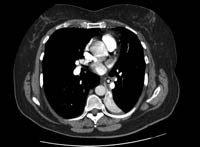Tests
1st tests to order
chest x-ray
Test
Initial imaging modality of choice in suspected foreign body aspiration.[4]
Radiopaque foreign bodies are seen in only 2% to 19% of patients because most aspirated objects are radiolucent.
Organic materials such as meat and vegetables are difficult to visualize.[35]
The sensitivity of chest radiograph performed in the emergency department for foreign body aspiration has been reported to be 22.6%.[37] False-negative rates vary between 5% and 30% in children and between 8% and 80% in adults, probably because of differences in the physical properties of the aspirated materials.
Nonspecific findings that suggest foreign body aspiration include atelectasis, pneumonia, air trapping, and pneumomediastinum. Bronchiectasis, lung abscess, and empyema are usually late findings.
A normal chest radiograph does not rule out foreign body aspiration, and CT scan or bronchoscopy is warranted for confirmation.
Result
radiopaque foreign bodies can be visualized
Tests to consider
CT chest
Test
In children, low-dose multidetector CT (MDCT) scanning with virtual bronchoscopy (VB) can be used to diagnose foreign body aspiration, and to determine the exact location of the obstruction. It has a sensitivity of 92% to 100% and specificity of 80% to 85%.[41][42] False-positives occur because of secretions and endobronchial tumors. In adults, bronchoscopy should be subsequently performed for confirmation or to diagnose alternative causes of airway obstruction.[Figure caption and citation for the preceding image starts]: CT of the chest with intravenous contrast material showing complete left lower lobe collapse with a radiopaque object within the left lower main bronchus surrounded by a halo of airBMJ Case Reports 2008 (doi:10.1136/bcr.06.2008.0013). Copyright 2008 BMJ Group Ltd [Citation ends].
Result
foreign body can be seen in the airway lumen; indirect common findings include atelectasis, hyperlucency, and lobar consolidation
bronchoscopy
Test
Rigid bronchoscopy may be considered as the initial diagnostic and therapeutic test in pediatric patients with asphyxia; radiopaque foreign body; or in the presence of associated unilateral decreased breath sounds, localized wheezing, hyperinflation, or atelectasis.[14][43][44][45] In all other circumstances, flexible bronchoscopy should be performed first for diagnostic confirmation.[14][45]
In stable children with suspected foreign body aspiration, flexible bronchoscopy has been shown to safely confirm the diagnosis and can be used for therapeutic purposes.[5][44][46][47]
In stable adults, flexible bronchoscopy should be used initially to confirm suspected cases of foreign body aspiration and to attempt removal of the foreign body.[4][51][52][53] It is the initial method of choice in patients with cervicofacial trauma and in those on mechanical ventilation. In these patients, rigid bronchoscopy should be reserved as a therapeutic approach rather than as a diagnostic tool.
Result
determines the nature of the foreign body, its location, the degree of airway obstruction, and associated mucosal abnormalities
Emerging tests
ultrasound lung
Test
Point-of-care ultrasound (POCUS) findings have been reported in a prospective, observational, cross-sectional study of children with foreign body aspiration.[56] However, sample size was small.
Prospective direct comparisons of lung ultrasound with chest x-ray are required.
Result
findings in patients with foreign body aspiration may include B-lines, barcode sign, pleural line abnormalities, and consolidation
Use of this content is subject to our disclaimer